Caryn’s Thoughts
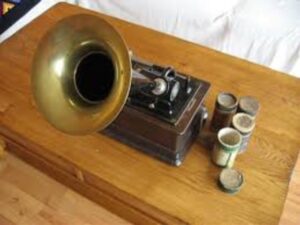
 Over the years, the distribution of music has taken many forms, and these days most kids would have no idea how to use the vast majority of them. From sheet music that must be played to hear it, to digital music that can be taken with us wherever we go, music is an important part of our lives. Before 1877, sheet music was all there was. If people couldn’t play an instrument or read music, the had to hope they could learn a song by hearing it and learning to replicate it with their own voice. Sometimes that works, and sometimes it doesn’t.
Over the years, the distribution of music has taken many forms, and these days most kids would have no idea how to use the vast majority of them. From sheet music that must be played to hear it, to digital music that can be taken with us wherever we go, music is an important part of our lives. Before 1877, sheet music was all there was. If people couldn’t play an instrument or read music, the had to hope they could learn a song by hearing it and learning to replicate it with their own voice. Sometimes that works, and sometimes it doesn’t.
In 1877, an inventor by the name of Thomas Edison came up with a way of recording and playing back audio. The sound quality has changed as much over the years as the vehicle of distribution. The first vehicle for music distribution was a wax cylinder, but that was later changed to a seven-inch disc made from a kind of polyurethane compound by the 1920s. Polyurethane is a type of plastic.
The polyurethane discs worked quite well, but as with most things…improvements can always be made. These new discs brought music to the masses, with record sales reaching around one hundred million in 1927. Then in 1948, the discs became obsolete when the first vinyl records were introduced. There were two versions of the vinyl records, made by two different companies. RCA Company came up with the 45 RPM records, because they thought that the records should hold only one song, while Columbia wanted to be able to have multiple songs in one place, so they came up with the LP 33? RPM which was introduced on June 18, 1948. The vinyl 33? RPM LPs and the cheaper 45 RPM singles remained the dominant format throughout the 1950s.
Like all other forms of technology, vinyl eventually became obsolete when the compact audio cassette came out in 1963. The audiocassette dominated other formats, such as the 8-Track Tape, after the advent of the Sony Walkman in the late 1970s. The Walkman made music portable and within five years, cassette tapes were outselling records. Then, almost like history repeating itself, discs came back into being…this time in the form 
 of the compact disc (CD). The CD could hold around 80 minutes of music, and after its release in 1982, it quickly became the best way to storing music. By 2007, over two hundred billion CDs had been bought and sold worldwide. Of course, we all know that while you can still buy CDs, they too have been replaced…this time by digital music. Now, I know that I may be the exception in my age group, but I like the digital music, as well as the digital books, and even audio books. It is so much more convenient and takes up much less space.
of the compact disc (CD). The CD could hold around 80 minutes of music, and after its release in 1982, it quickly became the best way to storing music. By 2007, over two hundred billion CDs had been bought and sold worldwide. Of course, we all know that while you can still buy CDs, they too have been replaced…this time by digital music. Now, I know that I may be the exception in my age group, but I like the digital music, as well as the digital books, and even audio books. It is so much more convenient and takes up much less space.
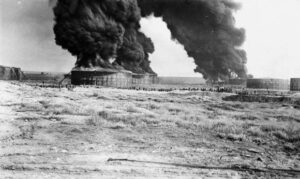 Recently, oil has taken a huge political hit, but most people know that oil is used for far more than the running vehicles. Oil has provided necessary energy to the United States, and even the electric cars can’t exist without petroleum products to make the wiring, tires, seats, floormats, hoses, and much more. In fact, most of us know that there is almost no area of life that isn’t affected by oil. It is part of the makeup of so many things. So, it is silly to think that we can run anything in this world completely void of oil. Living in Wyoming, I know of the value of oil, and many in my family work or have worked in the oil industry.
Recently, oil has taken a huge political hit, but most people know that oil is used for far more than the running vehicles. Oil has provided necessary energy to the United States, and even the electric cars can’t exist without petroleum products to make the wiring, tires, seats, floormats, hoses, and much more. In fact, most of us know that there is almost no area of life that isn’t affected by oil. It is part of the makeup of so many things. So, it is silly to think that we can run anything in this world completely void of oil. Living in Wyoming, I know of the value of oil, and many in my family work or have worked in the oil industry.
Casper, Wyoming has deep roots in the oil industry, and has long provided necessary energy for the nation. Casper’s roots began early on. In 1895, a man named Mark Shannon and a group of Pennsylvania investors opened the state’s first oil refinery in Casper. It was the beginning of an important economic future for Casper and the state. At first, the refinery was able to produce 100 barrels of lubricants per day…not a lot by today’s standards, but in those days, it was phenomenal. Since then, the oil industry has enjoyed a long and successful history, even if the industry did struggle at times. Wyoming is a “Boom-and-Bust” state. We have always been subject to that cycle.
Nevertheless, the early oil fields were quite successful. The Salt Creek and Shannon fields are located in central 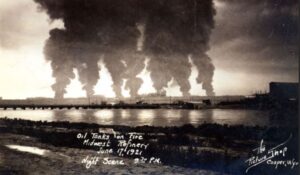 Wyoming. With them came the refineries and later, out of necessity, the tank farm oil storage facilities. Storing large quantities of oil, while relatively safe, faces the inevitable possibility of a fire. Safety was always a goal, but it seems an impossible task to stop all fires. The Casper refinery had their first boiler fire on March 5, 1895. Then came the construction of the Casper Tank Farm. According to the Natrona Tribune, reporting on April 18, 1895, “Workmen are now busy sinking a six-hundred-barrel storage reservoir for crude oil and a number of other new tanks and the machinery necessary to finish all grades of oil will be placed as soon as workmen can do so.” I’m sure this was both for storage and safety, but with oil, there is no guarantee.
Wyoming. With them came the refineries and later, out of necessity, the tank farm oil storage facilities. Storing large quantities of oil, while relatively safe, faces the inevitable possibility of a fire. Safety was always a goal, but it seems an impossible task to stop all fires. The Casper refinery had their first boiler fire on March 5, 1895. Then came the construction of the Casper Tank Farm. According to the Natrona Tribune, reporting on April 18, 1895, “Workmen are now busy sinking a six-hundred-barrel storage reservoir for crude oil and a number of other new tanks and the machinery necessary to finish all grades of oil will be placed as soon as workmen can do so.” I’m sure this was both for storage and safety, but with oil, there is no guarantee.
That fact was never made so clear as it was on June 17, 1921, when lightning caused seven oil tanks to catch fire. This became known as the Midwest Oil Tank Farm Battle…and what a battle it was. In those days there was no set plan for fighting a fire in a refinery or a tank farm. It is something you really pray never happens. When lightning struck…in a very real way, they had to figure out how to get it under control, and not lose all of that oil in the tanks. Someone came up with the idea of piercing the tanks below the fire line, thus allowing the oil to drain into the fire dykes. The oil could then be scooped up and pumped into surrounding tanks that were not involved in the fire. It was definitely a great idea, but how were they going to do that?
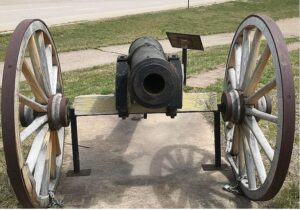
After giving it some thought, they decided to use some cannons from World War I. The first shot from the cannon hit high, and the oil gushed out toward the men firing the cannon. I’m sure that with the fires around them they must have panicked at least a little bit. These men weren’t firefighters. They were soldiers, so fire was not the enemy they were used to fighting. In all, nine shots were fired that day. One was aimed at a very high angle, and it flew off into areas unknown. Two of them went very low and were buried in the dirt under the tanks. Six shots were right on target. In the end, the operation was successful, and the fire was finally brought under control.
 Since tobacco has been proven to cause cancer, its use has declined to a degree, leaving growers, producers, and warehouses in the wake. One such warehouse is The Tobacco Warehouse in Liverpool, England. With the decline of tobacco use, the warehouse became a ghost. Of course, it was a warehouse, and could have continued to be useful, but somehow, no one wanted to use it, and it slowly fell into disrepair. The logical solution would have been to tear it down, but since the site is considered a key landmark and World Heritage Site, it can’t be torn down. So, what now?
Since tobacco has been proven to cause cancer, its use has declined to a degree, leaving growers, producers, and warehouses in the wake. One such warehouse is The Tobacco Warehouse in Liverpool, England. With the decline of tobacco use, the warehouse became a ghost. Of course, it was a warehouse, and could have continued to be useful, but somehow, no one wanted to use it, and it slowly fell into disrepair. The logical solution would have been to tear it down, but since the site is considered a key landmark and World Heritage Site, it can’t be torn down. So, what now?
The Tobacco Warehouse was built in 1901, and the dream was to build the biggest warehouse the world had ever seen. It was to be a building fit for a  thriving city at the heart of global trade…Liverpool, England. They thought this was going to be a thriving business that would last a lifetime, but they didn’t plan on the fallout from the discovery that tobacco was linked to cancer. Suddenly everyone was quitting, or at least encouraged to do so, and the warehouse was used less and less…and finally not at all.
thriving city at the heart of global trade…Liverpool, England. They thought this was going to be a thriving business that would last a lifetime, but they didn’t plan on the fallout from the discovery that tobacco was linked to cancer. Suddenly everyone was quitting, or at least encouraged to do so, and the warehouse was used less and less…and finally not at all.
Operations at The Tobacco Warehouse stopped in the last portion of the 20th century, and its decline began then. So many old buildings, when they are no longer taken care of, begin to simply fall apart and become a danger to anyone who gets near them. The thing about The Tobacco Warehouse, was  that it wasn’t an ugly building, and it had some amazing views. It was right by the water. In fact, because it was a harbor warehouse, it had the uniqueness of the docks and the view over the water. The whole thing together seemed perfect to create an apartment complex. Of course, it would be something geared toward the young people, artists, and writers, but of course, anyone could rent there as well. They are actually called “hipster lofts.” So, the Tobacco Warehouse in Liverpool’s Stanley Dock could become the city’s newest residential hotspot, and all worthy of a Beatle! Most people wouldn’t really consider living in a warehouse, but the industrial look is very popular now, so this is a good fit.
that it wasn’t an ugly building, and it had some amazing views. It was right by the water. In fact, because it was a harbor warehouse, it had the uniqueness of the docks and the view over the water. The whole thing together seemed perfect to create an apartment complex. Of course, it would be something geared toward the young people, artists, and writers, but of course, anyone could rent there as well. They are actually called “hipster lofts.” So, the Tobacco Warehouse in Liverpool’s Stanley Dock could become the city’s newest residential hotspot, and all worthy of a Beatle! Most people wouldn’t really consider living in a warehouse, but the industrial look is very popular now, so this is a good fit.

 My grandnephew, James Renville, started “the last year of the first quarter of his life” (according to his mom, Toni Chase, who is feeling a little nostalgic these days) by marrying his perfect match, Manuela Ortiz. They really are polar opposites when it comes to their personalities, and that has been just perfect. James was always a quiet man, and Manuela is very outgoing. That’s just what James needed. These days, he is becoming more outgoing, and has even taken up some acting!! Manuela does some videos on Tik Tok, and James has been participating in those. It’s very interesting, and his transformation has been amazing. I think deep down, James has always had a little showmanship in him. He just needed a little help to draw “that guy” out. James loves inline skating and playing pool with his dad, Jim. It is just a couple of ways he unwinds. He is really good on the inland skates and can do some of the tricks some of the professional skaters do. I think that filming those tricks is another way he has been drawn out a little.
My grandnephew, James Renville, started “the last year of the first quarter of his life” (according to his mom, Toni Chase, who is feeling a little nostalgic these days) by marrying his perfect match, Manuela Ortiz. They really are polar opposites when it comes to their personalities, and that has been just perfect. James was always a quiet man, and Manuela is very outgoing. That’s just what James needed. These days, he is becoming more outgoing, and has even taken up some acting!! Manuela does some videos on Tik Tok, and James has been participating in those. It’s very interesting, and his transformation has been amazing. I think deep down, James has always had a little showmanship in him. He just needed a little help to draw “that guy” out. James loves inline skating and playing pool with his dad, Jim. It is just a couple of ways he unwinds. He is really good on the inland skates and can do some of the tricks some of the professional skaters do. I think that filming those tricks is another way he has been drawn out a little.



Following their wedding, the kids took a short honeymoon trip to Yellowstone National Park. They had a great time. James has always loved to travel, and so they also took several road trips over the last year to other parks in Wyoming and Colorado. They have just been enjoying their new life together. Now they are getting ready to move to a new place, and they are very excited about that. James is always up for a trip…be it for hiking or just sightseeing. James and Manuela are always game to see new places and do new things.

 James also started a new job in the world of Public Relations, and he loves it. It plays into his love of travel too, because his job requires that he travel quite a bit. His job takes him all around the Rocky Mountain region, specifically any states that border Wyoming, but that doesn’t mean that he doesn’t go further. He is headed to Portland, Or3gon in a couple of weeks, and might be slated to go to Houston, Texas next week as well. With James’ love of travel, these trips are awesome indeed, with the only drawback being that Manuela can’t go with him. Still, that makes the reunions that much sweeter for these young newlyweds…even if the time apart is less than ideal. Today is James’ 25th birthday. Happy birthday James!! Have a great day!! We love you!!
James also started a new job in the world of Public Relations, and he loves it. It plays into his love of travel too, because his job requires that he travel quite a bit. His job takes him all around the Rocky Mountain region, specifically any states that border Wyoming, but that doesn’t mean that he doesn’t go further. He is headed to Portland, Or3gon in a couple of weeks, and might be slated to go to Houston, Texas next week as well. With James’ love of travel, these trips are awesome indeed, with the only drawback being that Manuela can’t go with him. Still, that makes the reunions that much sweeter for these young newlyweds…even if the time apart is less than ideal. Today is James’ 25th birthday. Happy birthday James!! Have a great day!! We love you!!
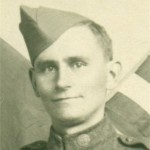
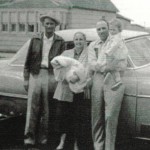 Growing up, I had only one set of grandparents. My dad’s parents were both in Heaven by the time I was six months old, so my grandparents were George and Harriet (Hattie) Byer. My grandpa was a tall man, but he was very slim. Still, I always thought of him as a big man…with big hands. I’m sure his slimness was due to several factors. In those days, everyone had large families, and my grandparents, with nine children, were no exception. That many kids during the Depression Years meant that food was a bit scarce, and my grandparents never turned away a hungry neighbor or any other hungry person, for that matter. My aunts and uncles can remember having strangers at the dinner table many times. Grandma would simply add a little more water to the soup to make things go a little further.
Growing up, I had only one set of grandparents. My dad’s parents were both in Heaven by the time I was six months old, so my grandparents were George and Harriet (Hattie) Byer. My grandpa was a tall man, but he was very slim. Still, I always thought of him as a big man…with big hands. I’m sure his slimness was due to several factors. In those days, everyone had large families, and my grandparents, with nine children, were no exception. That many kids during the Depression Years meant that food was a bit scarce, and my grandparents never turned away a hungry neighbor or any other hungry person, for that matter. My aunts and uncles can remember having strangers at the dinner table many times. Grandma would simply add a little more water to the soup to make things go a little further.
Grandpa Byer worked hard his whole life. He helped build Alcova Dam in Alcova, Wyoming. He was always considered a good worker and was always loyal and followed orders to the letter. Grandpa was always considered a dedicated employee. Grandpa was known to follow orders to the letter, and it actually saved his life one time while digging a ditch. When his boss walked by and saw the beginning of a cave in, he yelled, “Jump George!!” Grandpa immediately did as he was told, and his upper body was above ground after the cave in. Many people, these days, would have found themselves in a lot of trouble…even the ones who jokingly say they would ask, “How high.” There was no time to ask anything. Grandpa’s life depended on his immediate action…and I’m happy he followed those orders.
Grandpa was loved by all who knew him, and while his was a strong man, he was soft-spoken, and often quiet…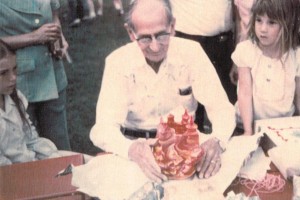
 something that might also have come from the fact that he had a big family. It’s not easy to get a word in when you have that many people all wanting to talk at the same time. Nevertheless, if Grandpa needed to make his voice heard, I’m sure he could. He was a man who commanded respect…not because people feared him, but because they loved him. Today is the 129th anniversary of my grandfather’s birth. Happy birthday in Heaven, Grandpa. We love and miss you very much.
something that might also have come from the fact that he had a big family. It’s not easy to get a word in when you have that many people all wanting to talk at the same time. Nevertheless, if Grandpa needed to make his voice heard, I’m sure he could. He was a man who commanded respect…not because people feared him, but because they loved him. Today is the 129th anniversary of my grandfather’s birth. Happy birthday in Heaven, Grandpa. We love and miss you very much.

 My great grandnephew, Max Herr is such a sweet little boy. I ran into him and his mommy, Katy Herr at Walmart the other day. He was a little shy, because he was meeting me for the first time, even though I have known him since birth. Nevertheless, he was talking to his mommy and saying “Clues…clues.” Well, I didn’t understand what he was saying, so I looked to Katy quizzically. Then it became clear when she told me that Max’s very favorite show is “Blue’s Clues.” It all became clear then. While two-year-old, Max couldn’t quite say “Blue’s Clues” yet, he knew exactly what he was talking about and what he wanted…his new “Blue’s Clues” placemat that was waiting for him in the shopping cart…cute!!
My great grandnephew, Max Herr is such a sweet little boy. I ran into him and his mommy, Katy Herr at Walmart the other day. He was a little shy, because he was meeting me for the first time, even though I have known him since birth. Nevertheless, he was talking to his mommy and saying “Clues…clues.” Well, I didn’t understand what he was saying, so I looked to Katy quizzically. Then it became clear when she told me that Max’s very favorite show is “Blue’s Clues.” It all became clear then. While two-year-old, Max couldn’t quite say “Blue’s Clues” yet, he knew exactly what he was talking about and what he wanted…his new “Blue’s Clues” placemat that was waiting for him in the shopping cart…cute!!
Max loves his mommy so much, but his daddy is his buddy. If his daddy is doing something, it must be the 
 most important thing in the world. Recently, Max has taken up golfing, because his daddy likes to golf. Max now has his own set of golf clubs, because he needs to learn the game, if he is going to play the game with his daddy. Golfing was never my game. In fact, the whole idea is beyond what I can see as a game of fun. Still, there are many people who love to golf, and fully understand the point of the game. My thought is that if you are going to play the game and teach it to your children, you should start young. They will learn it easily, and you can have a game to enjoy together.
most important thing in the world. Recently, Max has taken up golfing, because his daddy likes to golf. Max now has his own set of golf clubs, because he needs to learn the game, if he is going to play the game with his daddy. Golfing was never my game. In fact, the whole idea is beyond what I can see as a game of fun. Still, there are many people who love to golf, and fully understand the point of the game. My thought is that if you are going to play the game and teach it to your children, you should start young. They will learn it easily, and you can have a game to enjoy together.
Max loves to help with things. I don’t know how much help he is in the house, especially when it comes to picking up his toys, but he wants to help his daddy with the yard work, as well as any other work his daddy is doing. Max has a toy lawn mower, and he enjoys getting out there and taking care of the lawn, because after watching his daddy, he can see that the law and yard are very important. If his daddy works out there, it is a 
 given that Max needs to as well. I just love the way little boys mimic their dads. Just like little girls learn nurturing from their moms, boys learn the work ethic from their dads. It isn’t that moms don’t work and dads don’t nurture, it’s just that maybe girls think like their moms to a large degree and boys think like their dads to a large degree. Max is learning so much from both of his parents, and he is turning into a wonderful little boy. Today is Max’s 2nd birthday. Happy birthday Max!! Have a great day!! We love you!!
given that Max needs to as well. I just love the way little boys mimic their dads. Just like little girls learn nurturing from their moms, boys learn the work ethic from their dads. It isn’t that moms don’t work and dads don’t nurture, it’s just that maybe girls think like their moms to a large degree and boys think like their dads to a large degree. Max is learning so much from both of his parents, and he is turning into a wonderful little boy. Today is Max’s 2nd birthday. Happy birthday Max!! Have a great day!! We love you!!

 My nephew, Garrett Stevens is such a great “girl dad.” He reminds me a lot of my own dad, Al Spencer, his grandpa. These guys have proven that they know how to shine in a house full of girls. Garrett and his daughter, Elliott are always doing projects together. Elliott loves her daddy so much, and she wants to do whatever he is doing. As Garrett’s wife Kayla says, “Who needs boys?” Garrett would agree. His “little helper” is right there to help with whatever he is doing, and she does a pretty good job too. Garrett is so patient with her. They have painted together, and while Elliott is inexperienced and drips paint on the floor, Garrett never gets upset with her. He knows that painting, like any other work, is a learned skill, and he is teaching his daughter how to paint the best she can. Garrett has always been patient with kids, and his girl is no exception to that rule.
My nephew, Garrett Stevens is such a great “girl dad.” He reminds me a lot of my own dad, Al Spencer, his grandpa. These guys have proven that they know how to shine in a house full of girls. Garrett and his daughter, Elliott are always doing projects together. Elliott loves her daddy so much, and she wants to do whatever he is doing. As Garrett’s wife Kayla says, “Who needs boys?” Garrett would agree. His “little helper” is right there to help with whatever he is doing, and she does a pretty good job too. Garrett is so patient with her. They have painted together, and while Elliott is inexperienced and drips paint on the floor, Garrett never gets upset with her. He knows that painting, like any other work, is a learned skill, and he is teaching his daughter how to paint the best she can. Garrett has always been patient with kids, and his girl is no exception to that rule.
Garrett has been following in his grandpa’s footsteps in another way too…he is a certified welder, and he has been working at EMIT Technologies for a number of years now. All his hard work and dedication paid off a 
 month or so ago, when Garrett received a promotion to Welding Lead. It was such a proud moment for his wife, Kayla, who has watched him work very hard to provide for their family. For him to now have the recognition that he so greatly deserves makes Kayla so happy. She has always been so proud of Garrett. He is able to do just about any “jack-of-all-trades” kind of job, but he really excels at welding. Garrett also has the ability to lead. In fact, he is a natural, and his company saw that in him. Garrett was destined to lead, and so they are very happy about this new venture.
month or so ago, when Garrett received a promotion to Welding Lead. It was such a proud moment for his wife, Kayla, who has watched him work very hard to provide for their family. For him to now have the recognition that he so greatly deserves makes Kayla so happy. She has always been so proud of Garrett. He is able to do just about any “jack-of-all-trades” kind of job, but he really excels at welding. Garrett also has the ability to lead. In fact, he is a natural, and his company saw that in him. Garrett was destined to lead, and so they are very happy about this new venture.
These days, Garrett and Kayla are getting ready to expand their family, and we are all very excited for them. Their precious little one will be arriving very soon, and little Elliott will be a big sister. I know the whole family is excited for this next life step. Having two kids is different than having one, but it won’t be cause for drama in this down-to-earth family. It’s been so interesting to watch Garrett as he has grown and changed through the years. In some ways, like his love of children, there has been almost no change at all, but in others, like have 
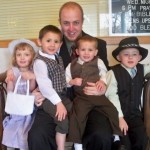 he has grown in his skills, there have been many wonderful changes. When he was younger, I never would have guessed that he would be a welder, but I always saw him as a dad. He was also a loving brother and cousin. His sisters, Michelle and Lacey were so blessed to have him as a brother, and he was very close with is cousins as well. Garrett was the life of the party at family gatherings and was always good for a laugh. His smile could light up a room, as could his laughter. I’m very proud of the man he turned into. Today is Garrett’s birthday. Happy birthday Garett!! Have a great day!! We love you!!
he has grown in his skills, there have been many wonderful changes. When he was younger, I never would have guessed that he would be a welder, but I always saw him as a dad. He was also a loving brother and cousin. His sisters, Michelle and Lacey were so blessed to have him as a brother, and he was very close with is cousins as well. Garrett was the life of the party at family gatherings and was always good for a laugh. His smile could light up a room, as could his laughter. I’m very proud of the man he turned into. Today is Garrett’s birthday. Happy birthday Garett!! Have a great day!! We love you!!
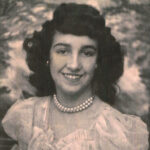
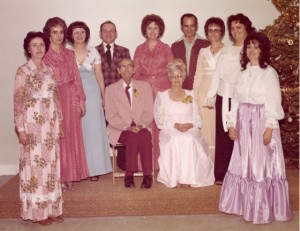 As the years go by, the number of aunts and uncles I have who are still living dwindles down. We don’t lose one or more every year, but they are slowly leaving us, and even years after they are in Heaven, I still think of them often, and especially on their birthdays. when I was a little girl, I somehow thought my Aunt Virginia Beadle was a tall (but not too tall) slim lady…and she was slim anyway. I suppose my own shortness made her seem taller, and I don’t know how tall she was in her tall days, but I know that in her latter years, she just got more and more tiny. Every time I saw her, I was amazed at how much more tiny and frail looking she
As the years go by, the number of aunts and uncles I have who are still living dwindles down. We don’t lose one or more every year, but they are slowly leaving us, and even years after they are in Heaven, I still think of them often, and especially on their birthdays. when I was a little girl, I somehow thought my Aunt Virginia Beadle was a tall (but not too tall) slim lady…and she was slim anyway. I suppose my own shortness made her seem taller, and I don’t know how tall she was in her tall days, but I know that in her latter years, she just got more and more tiny. Every time I saw her, I was amazed at how much more tiny and frail looking she  was, but she wasn’t sickly, and that was a good thing. Unfortunately, she was just getting older, and that was a bad thing.
was, but she wasn’t sickly, and that was a good thing. Unfortunately, she was just getting older, and that was a bad thing.
Aunt Virginia lived a full life, and she did so many things in her life. She worked much of her adult life…first for the telephone company, and then for the State of Wyoming. She was mom to three sons and two daughters. Her adopted son, Forest went to Heaven on July 3, 2005; and a daughter, Christy went to Heaven the day after her birth on November 20, 1967. Those were very sad events for Aunt Virginia, and I know that she is really enjoying her time with the children who went home ahead of her…as well as her husband, Uncle Bill Beadle who went home ahead of her too. Aunt Virginia was extremely saddened by every loss, but strong woman that she was, she persevered. That made her an inspiration to many…especially her children…and many of her nieces and nephews.
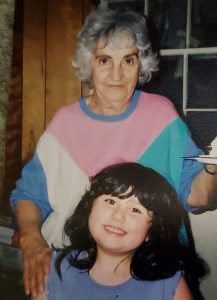
 The Byer girls were a beautiful bunch, and Aunt Virginia was no exception. I always thought of her as very sophisticated. Maybe it was because of how she dressed for the jobs she held. In those days, dresses were the norm…especially at work, and Aunt Virginia always looked stunning. I remember looking at her as a little girl and thinking how pretty she was. I think I always wanted to “dress up” like she did. She was very pretty, but more important than her beauty, was her sweet disposition. She was always thoughtful and kind, and that endeared her to many people…both at work and in her daily life. She was soft-spoken and kind, and we all loved her. Today would have been Aunt Virginia’s 92nd birthday. Happy birthday in Heaven, Aunt Virginia. We love and miss you very much.
The Byer girls were a beautiful bunch, and Aunt Virginia was no exception. I always thought of her as very sophisticated. Maybe it was because of how she dressed for the jobs she held. In those days, dresses were the norm…especially at work, and Aunt Virginia always looked stunning. I remember looking at her as a little girl and thinking how pretty she was. I think I always wanted to “dress up” like she did. She was very pretty, but more important than her beauty, was her sweet disposition. She was always thoughtful and kind, and that endeared her to many people…both at work and in her daily life. She was soft-spoken and kind, and we all loved her. Today would have been Aunt Virginia’s 92nd birthday. Happy birthday in Heaven, Aunt Virginia. We love and miss you very much.

 The cold war was one of the strangest times in world history. It wasn’t a war…exactly, but a period of geopolitical tension between the United States and the Soviet Union and their respective allies, the Western Bloc, and the Eastern Bloc, which began following World War II. While the war did not really “act” like a war, at least 389 soldiers were killed in the line of duty, as estimated by the American Cold War Veterans. These casualties were the result of planes being shot down by the Communist forces of the Soviet Union. One such plane was an American Navy P2V-3W was shot down near Vladivostok over the Sea of Japan by Soviet forces in November of 1951. The P2V-3W exploded off the coast, and the crew of 10 American soldiers was reported as missing. The Soviets accused the crew of gathering intelligence, and the Americans claimed that the mission was related to weather reconnaissance. The truth may never be really known. There were many other hazards that Americans were exposed to during the conflict. An estimated 400,000 people were subject to harm from toxins, which killed more than half of those who were exposed to them. Several thousand soldiers also lost their lives during these years in training accidents and friendly-fire incidents. So, while there were never any “battles” there were losses.
The cold war was one of the strangest times in world history. It wasn’t a war…exactly, but a period of geopolitical tension between the United States and the Soviet Union and their respective allies, the Western Bloc, and the Eastern Bloc, which began following World War II. While the war did not really “act” like a war, at least 389 soldiers were killed in the line of duty, as estimated by the American Cold War Veterans. These casualties were the result of planes being shot down by the Communist forces of the Soviet Union. One such plane was an American Navy P2V-3W was shot down near Vladivostok over the Sea of Japan by Soviet forces in November of 1951. The P2V-3W exploded off the coast, and the crew of 10 American soldiers was reported as missing. The Soviets accused the crew of gathering intelligence, and the Americans claimed that the mission was related to weather reconnaissance. The truth may never be really known. There were many other hazards that Americans were exposed to during the conflict. An estimated 400,000 people were subject to harm from toxins, which killed more than half of those who were exposed to them. Several thousand soldiers also lost their lives during these years in training accidents and friendly-fire incidents. So, while there were never any “battles” there were losses.
Because of the Nazi loss in World War II, and the surrender in 1945, the nation’s capital, Berlin, was divided into four sections, with the Americans, British, and French controlling the western region, and the Soviets controlling the eastern region. The three western sections came together as the Federal Republic of Germany (West Germany). East Germany became the German Democratic Republic in October of that same year. With tensions mounting, the border between the two new countries was closed in 1952, and by the following year East Germans were prosecuted if they left their country without permission. The situation grew worse when in August 1961, the Berlin Wall was erected by the East German government to prevent its citizens from escaping to the West. People were trying to escape every day, and between 1949 and night the wall went up, an estimated 2.5 million East Germans fled to the West.
By the time President Ronald Reagan was in office, the Cold War had started to really get old. Something had to change, and Reagan was determined to do something to stop the feuding. Like all presidents, part of keeping the people informed on matters of importance is making speeches, and on June 12, 1987, President Reagan made one of his most famous Cold War speeches, when he issued a challenge to Soviet Leader Mikhail Gorbachev to “tear down” the Berlin Wall. With the Berlin Wall behind him, Reagan said, “There is one sign the Soviets can make that would be unmistakable, that would advance dramatically the cause of freedom and peace.” He then called upon his Soviet counterpart: “Secretary General Gorbachev, if you seek peace—if you seek prosperity for the Soviet Union and Eastern Europe—if you seek liberalization: come here, to this gate. Mr. Gorbachev, open this gate. Mr. Gorbachev, tear down this wall.” The speech was also intended to ask Gorbachev to undertake serious arms reduction talks with the United States.
Many people thought that Reagan’s speech as a dramatic appeal to Gorbachev to renew negotiations on nuclear arms reductions, but it was also a reminder that despite Gorbachev’s public statements about a new 
 relationship with the West, the United States also wanted to see action taken to lessen Cold War tensions. The people of East Berlin just wanted freedom, and two years later, on November 9, 1989, East and West Germans got their way when the people broke down the infamous wall between East and West Berlin. Germany was officially reunited on October 3, 1990.
relationship with the West, the United States also wanted to see action taken to lessen Cold War tensions. The people of East Berlin just wanted freedom, and two years later, on November 9, 1989, East and West Germans got their way when the people broke down the infamous wall between East and West Berlin. Germany was officially reunited on October 3, 1990.
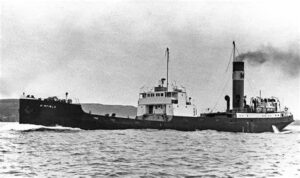 Shipwrecks have always intrigued me. Of course, you always hope that everyone got out alive, but the unfortunate truth is that usually that is not the case. Most shipwrecks sink to the bottom of the ocean, and often it takes years to even fins them. That was not the case with the SS Ayrfield, as well as a couple of other ships that “sank” in plain sight.
Shipwrecks have always intrigued me. Of course, you always hope that everyone got out alive, but the unfortunate truth is that usually that is not the case. Most shipwrecks sink to the bottom of the ocean, and often it takes years to even fins them. That was not the case with the SS Ayrfield, as well as a couple of other ships that “sank” in plain sight.
The SS Ayrfield was built in 1911, and it really didn’t sink. The plan was for it to be decommissioned and scrapped. The SS Ayrfield’s fate was sealed. She had served faithfully for 60 years, having been built in Scotland and sailed to Australia. She was used as a transport supply boat to US troops in the Pacific in World War II, and then retired. She was then used to run coal from Newcastle to Sydney for the rest of her working life. She was finally sent to Homebush Bay, which is where the old marine wrecking yards were. Ships didn’t come back from Homebush Bay. That feels a little sad to me. The plan was to scrap the ship, but that wasn’t exactly what happened.

As the ships sat rusting, waiting for the final scrapping, somehow it just didn’t happen. As they sat there, their insides slowly became completely colonized by mangrove trees. Branches and bark replaced the railings and ropes. The trees have taken root and as they have grown, they have created a giant leafy dome over the slowly disappearing hull. The ships have become known as the “Floating Forest” for obvious reasons, and just like a forest, their beauty is amazing.
Homebush Bay is actually home to the remains of the SS Ayrfield, as well as her neighbors, SS Mortlake Bank, steam tugboat SS Heroic, and boom defense vessel HMAS Karangi, all of which were broken up in the early 1970s. It is thought that there may be as many as seven ships in the bay. They now lie near the south-western shore of the bay, and they are completely visible from land and the hundreds of homes just a short distance away. Some people consider the ship graveyard, a little creepy, but since these weren’t sinkings with a loss of life, I think they are very cool.
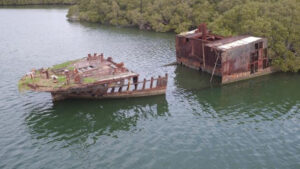
Unfortunately, during the 20th century, Homebush Bay was a heavy industry center, home to many industrial facilities. When industrial operations scaled down, the bay became a dumping ground for a large range of unwanted material…from waste to broken up ships, even toxic industrial waste. Union Carbide had manufactured chemicals, including Agent Orange, on the site and dioxins produced as a byproduct were buried in landfill or left in drums. The area has been in the process of being reclaimed, but fishing is prohibited, and I would not want to go in the water. It just doesn’t seem safe…even if it is beautiful.

